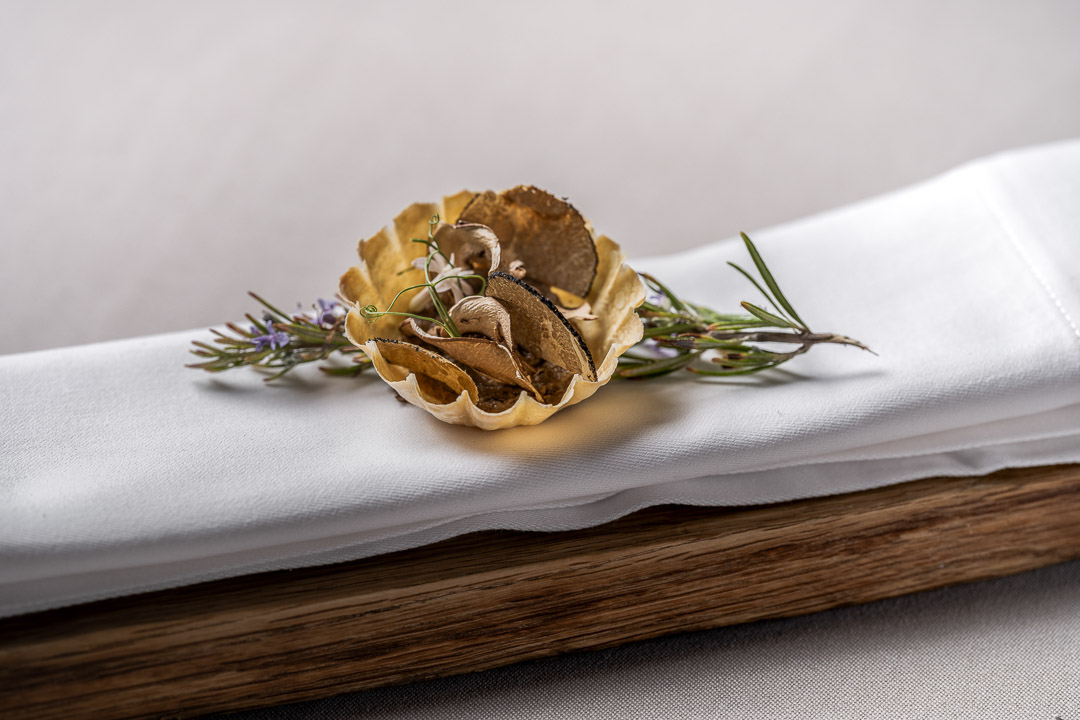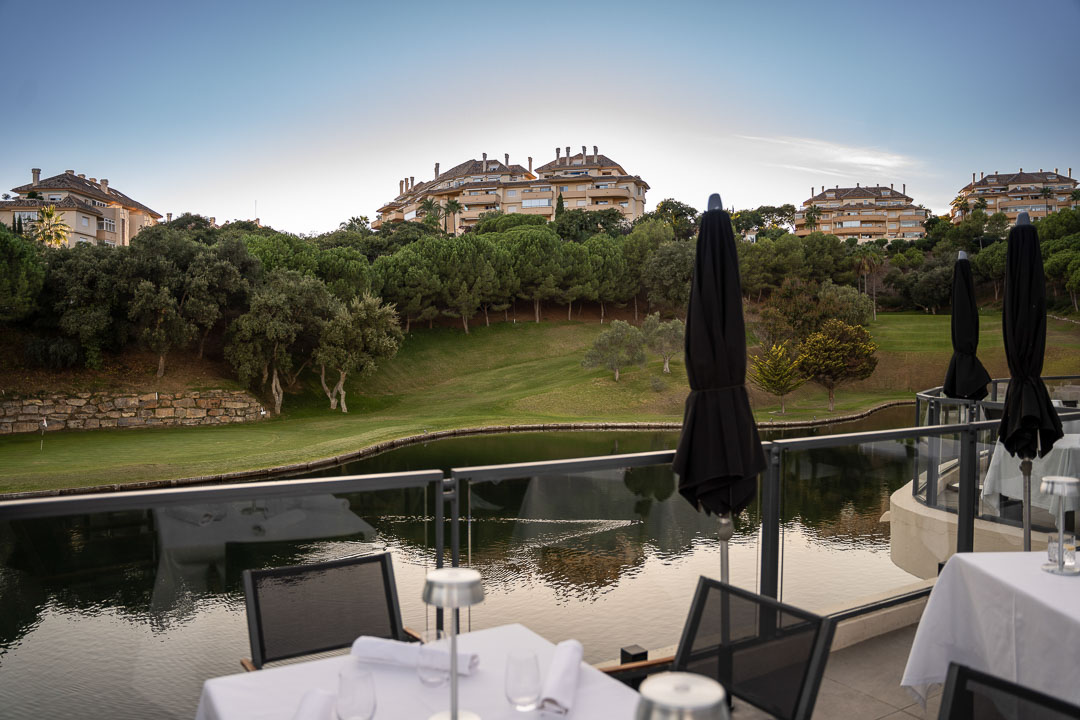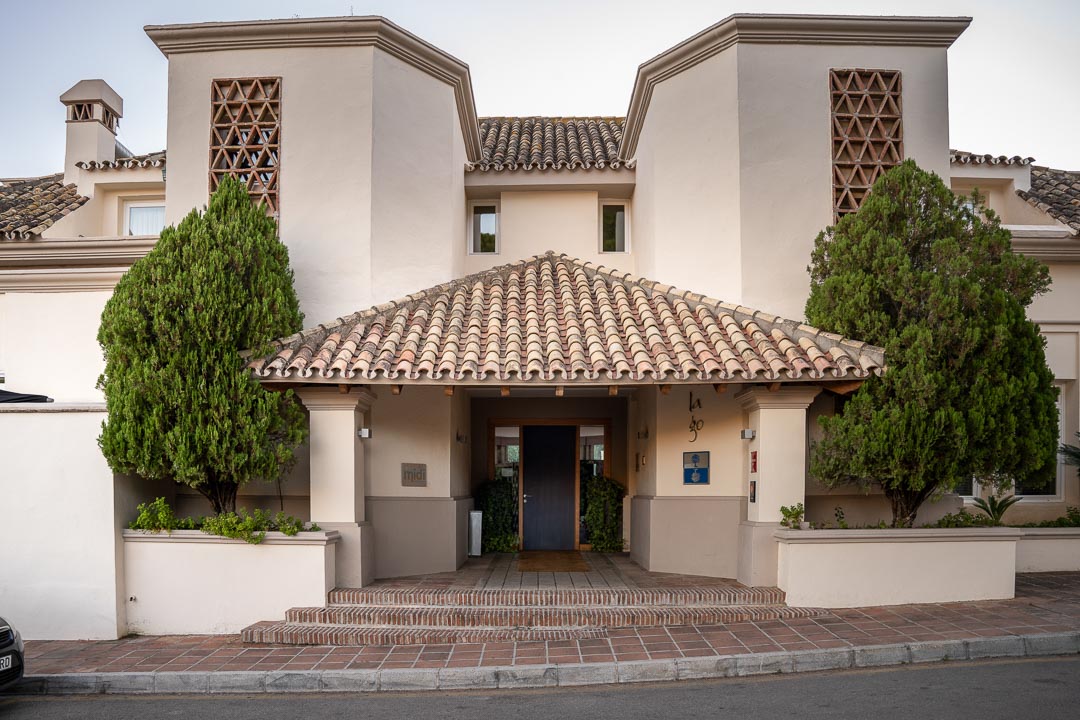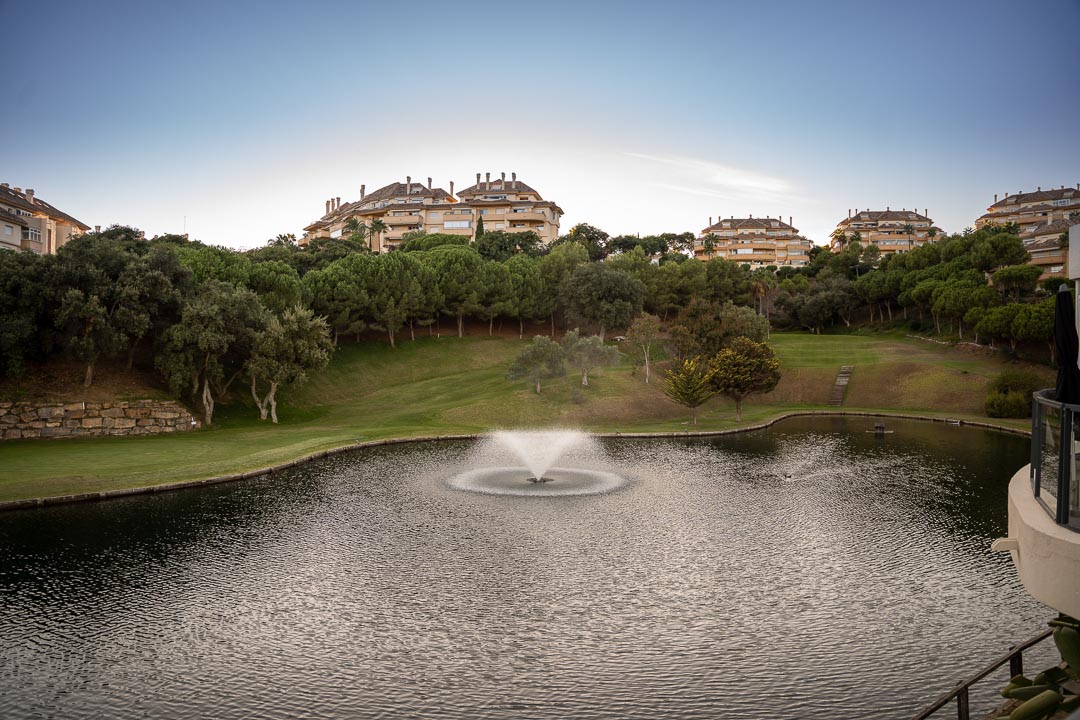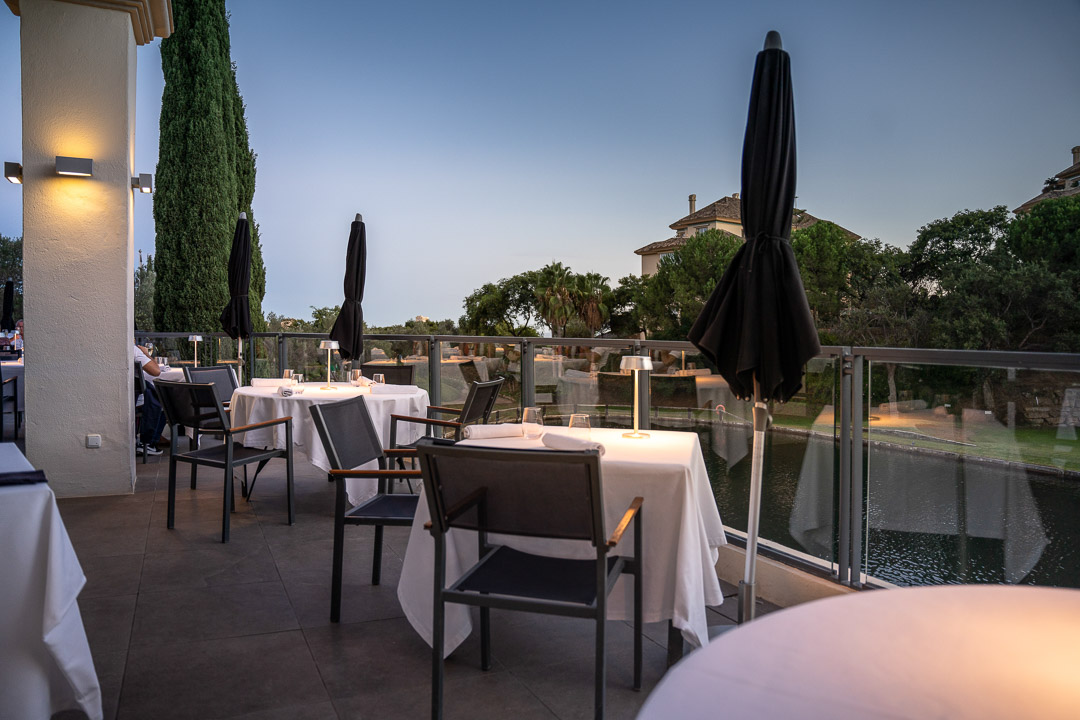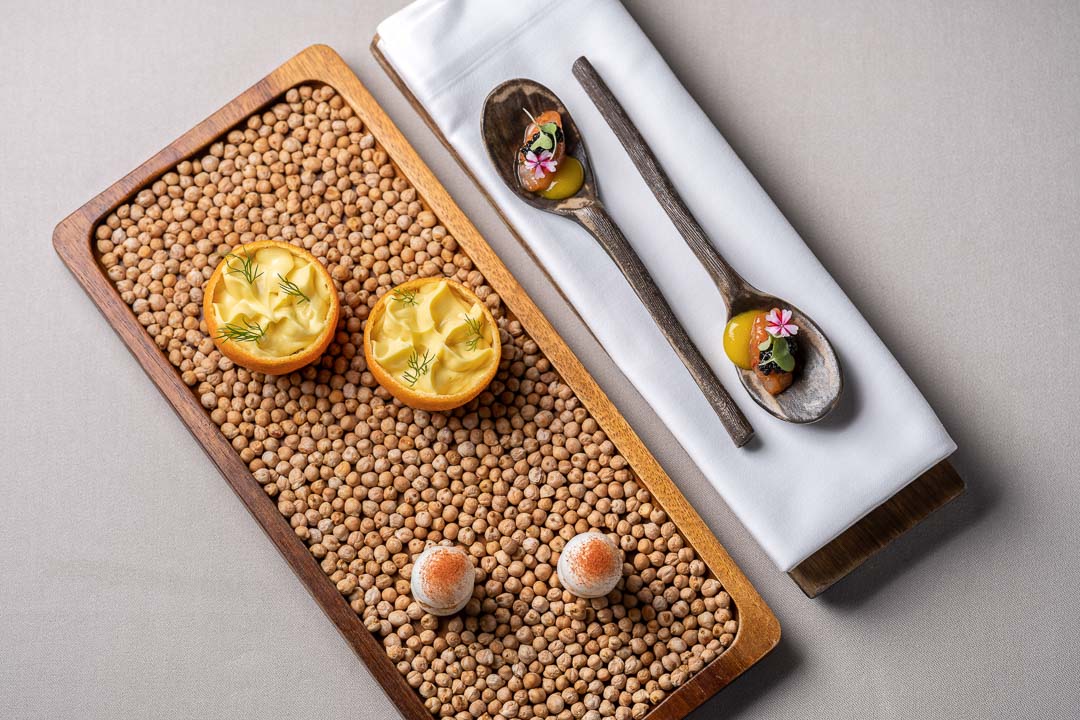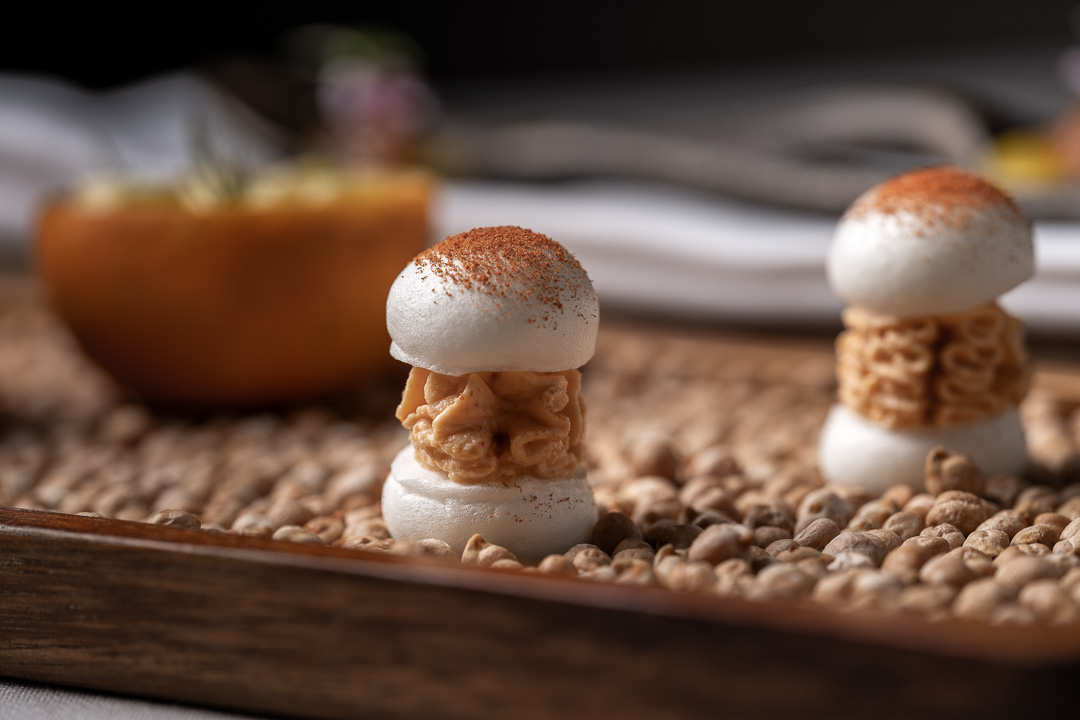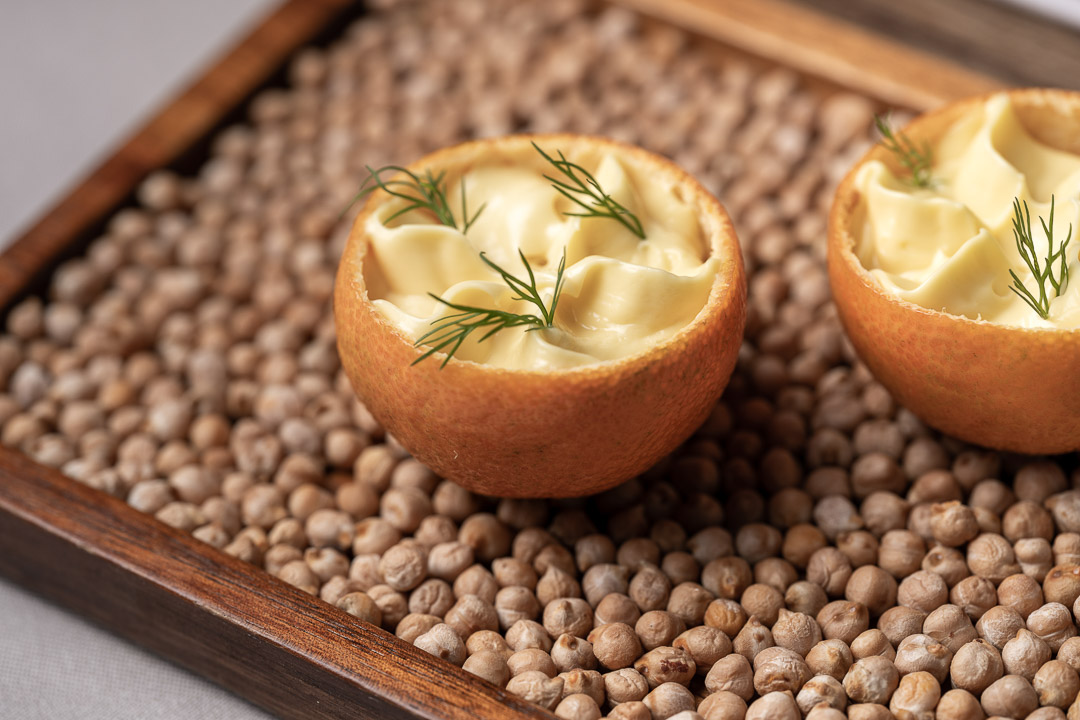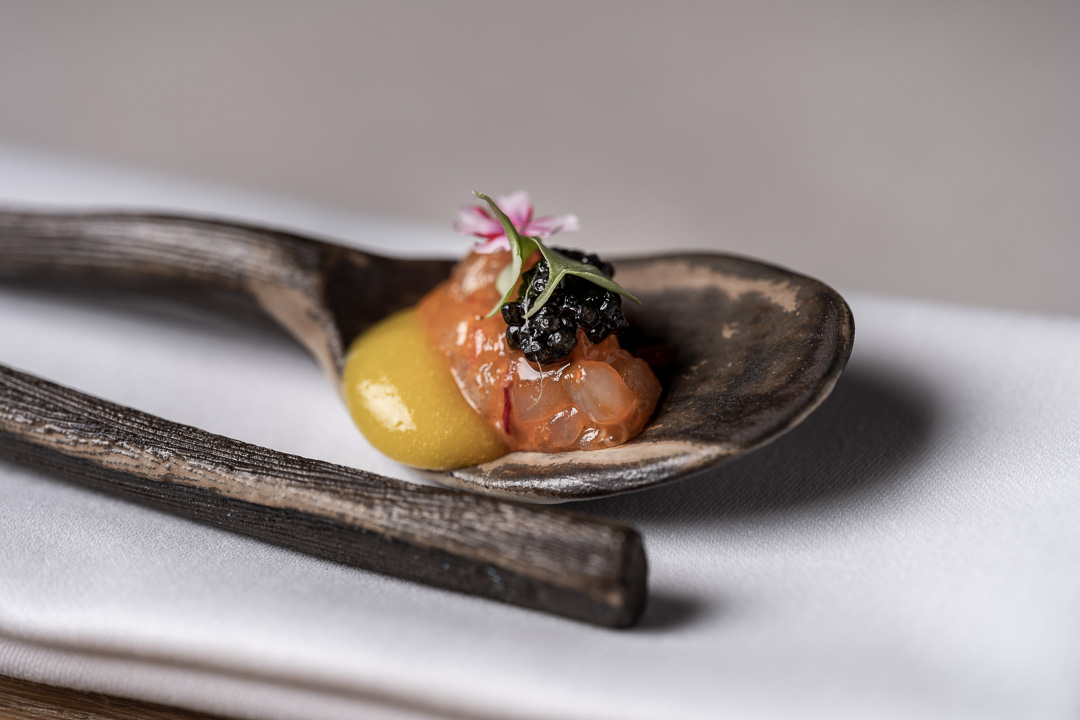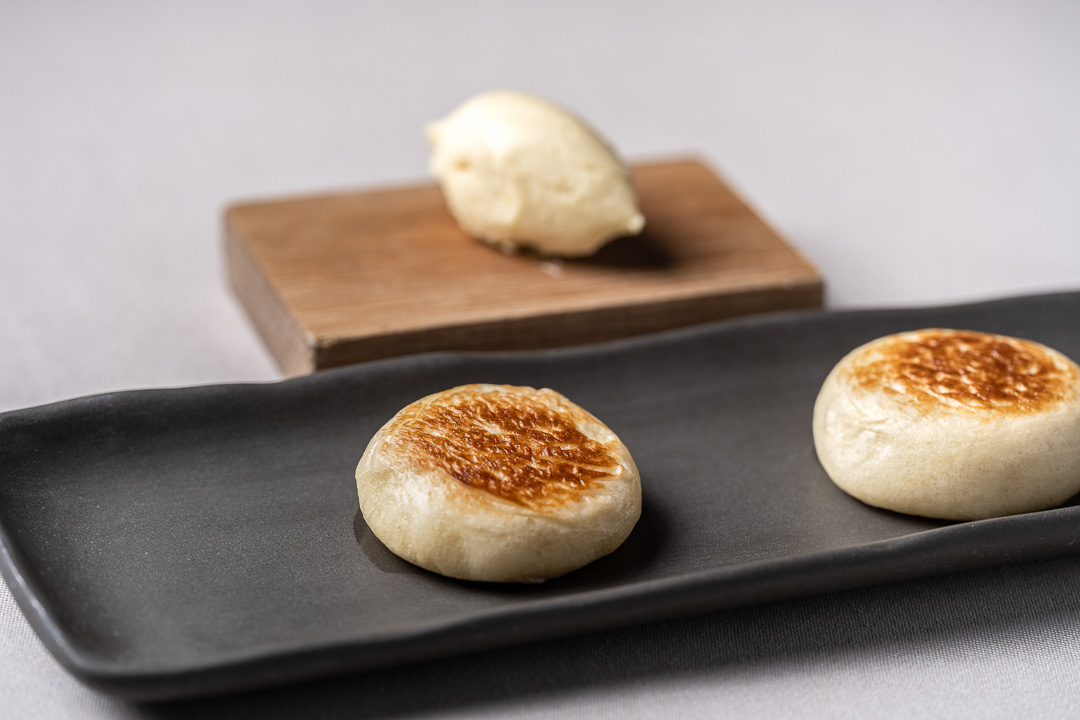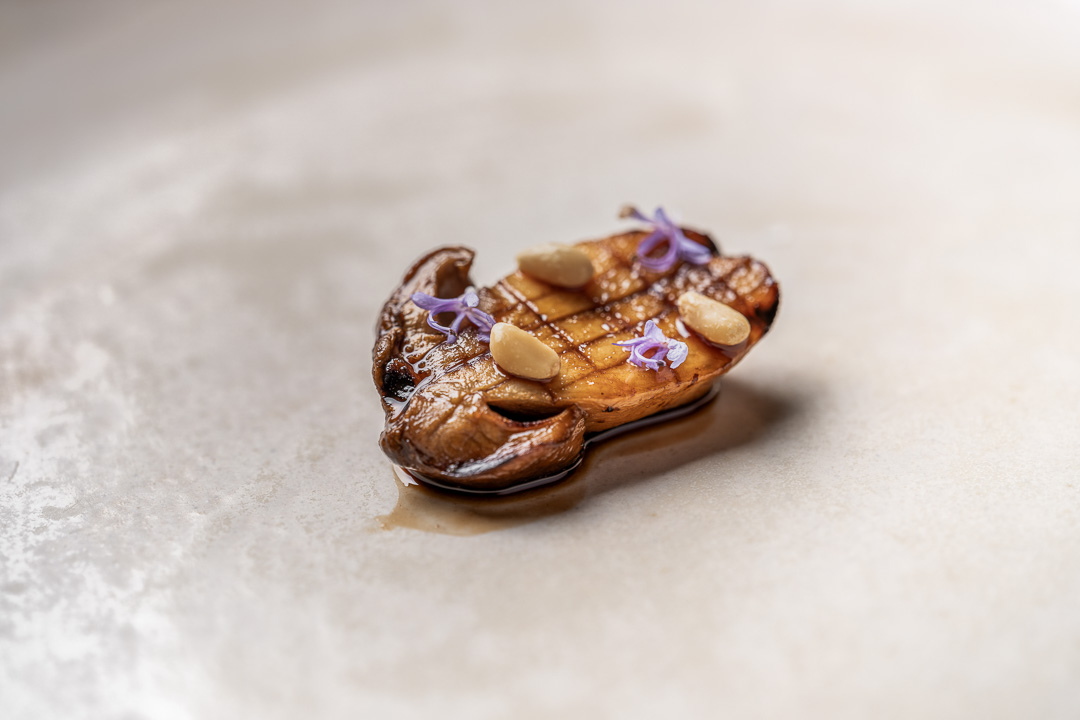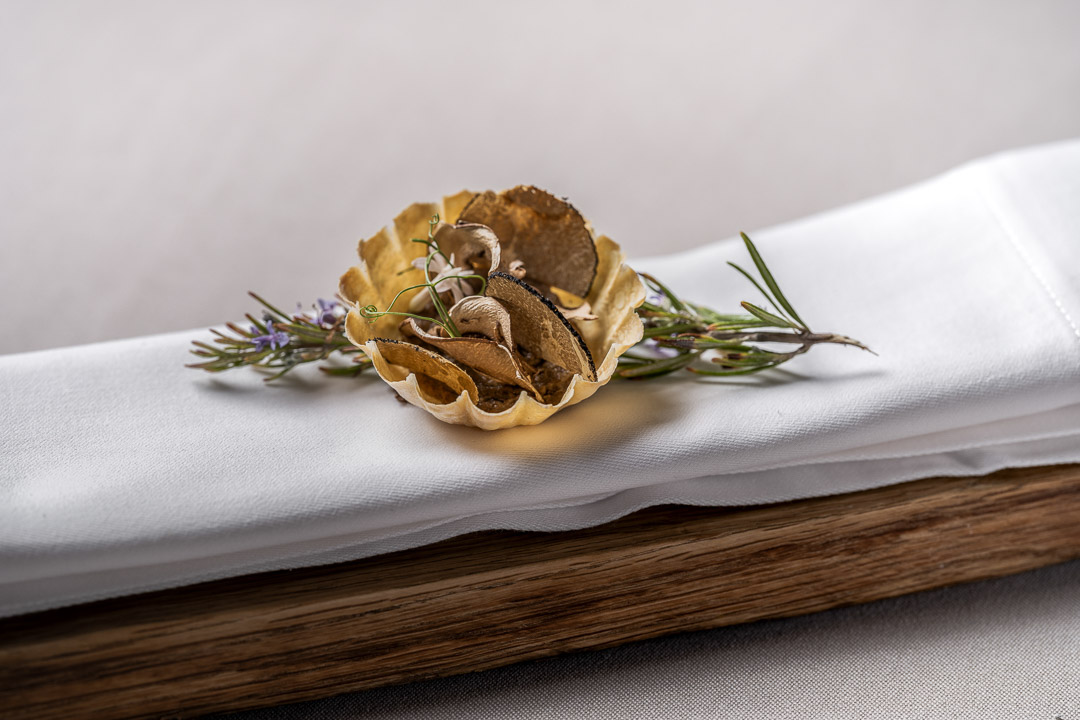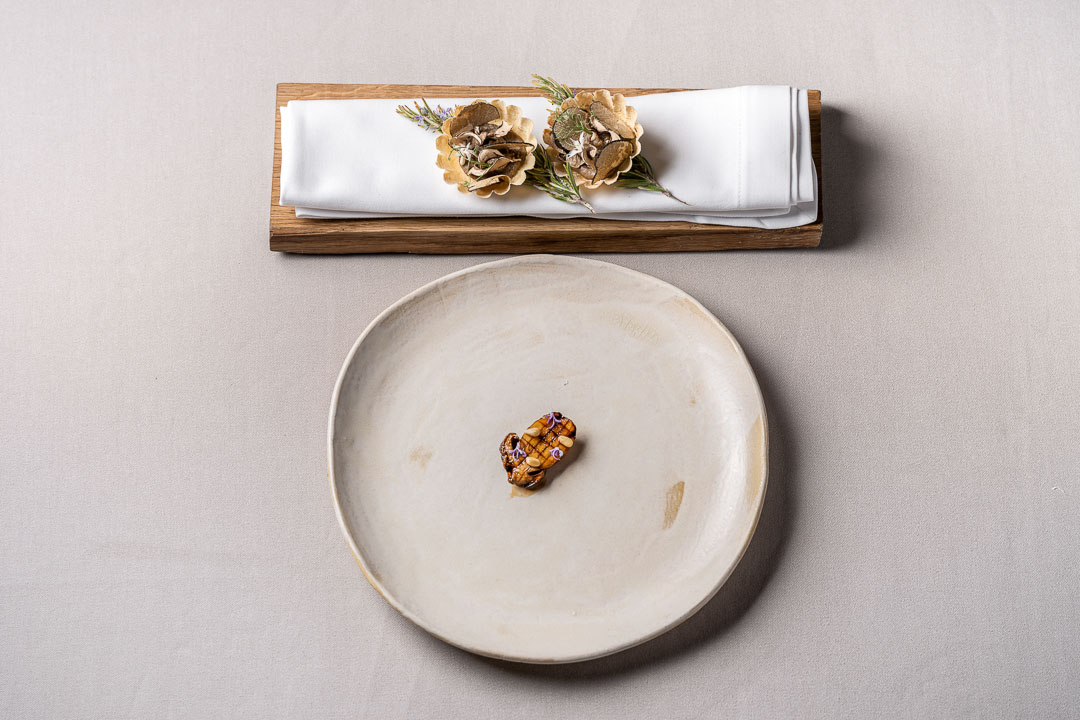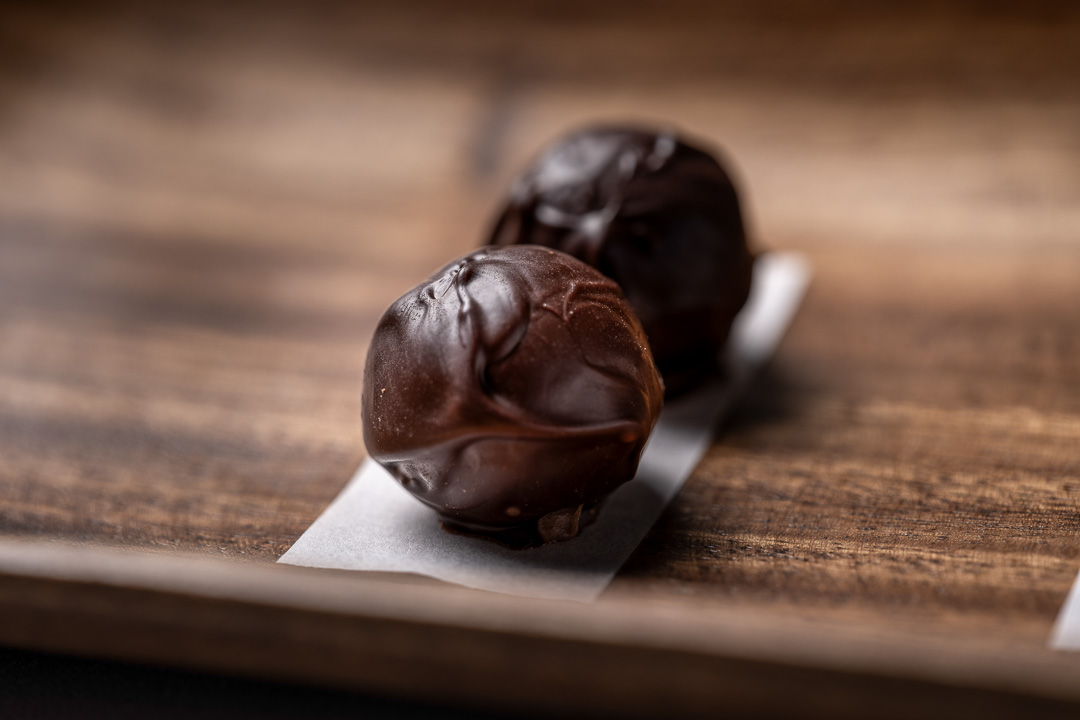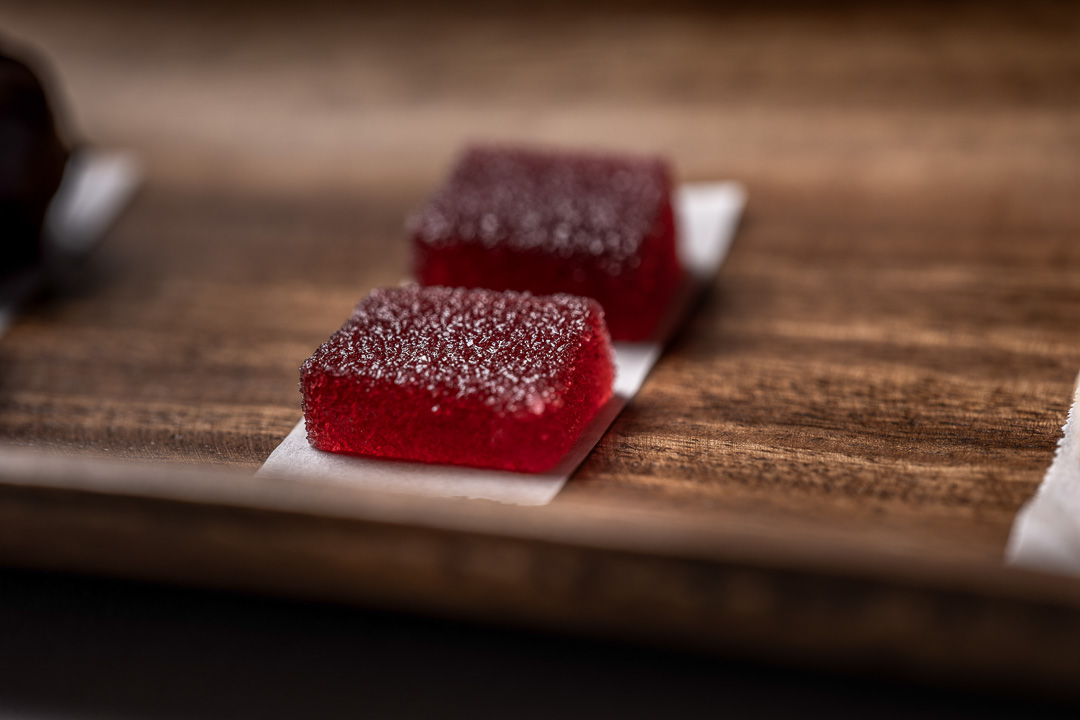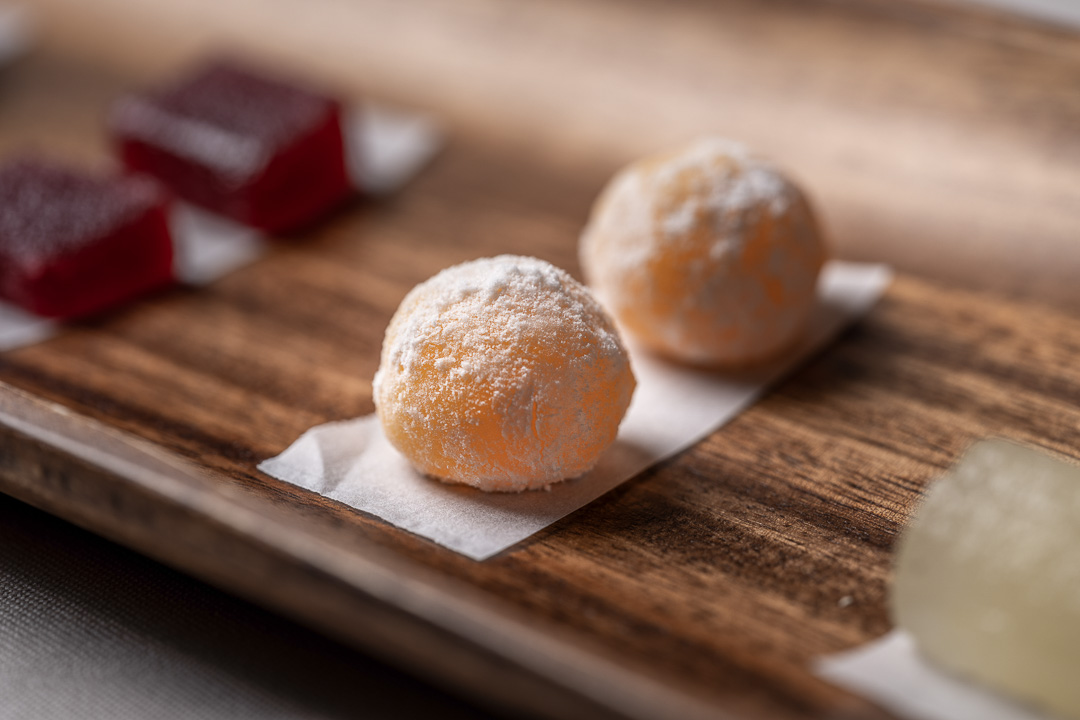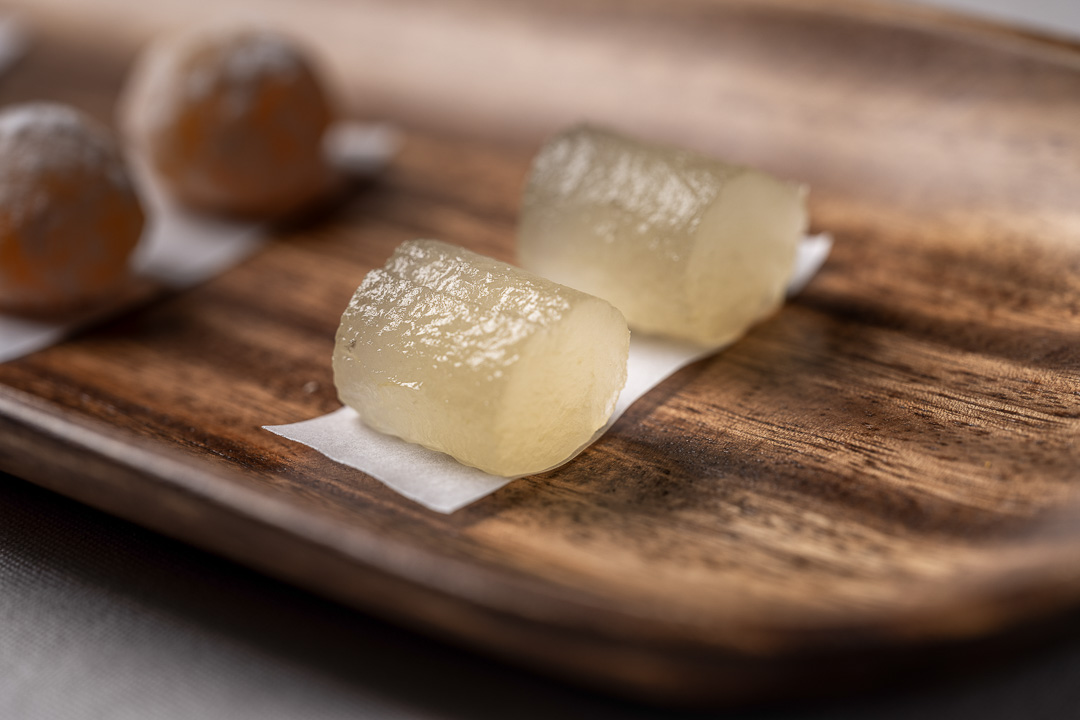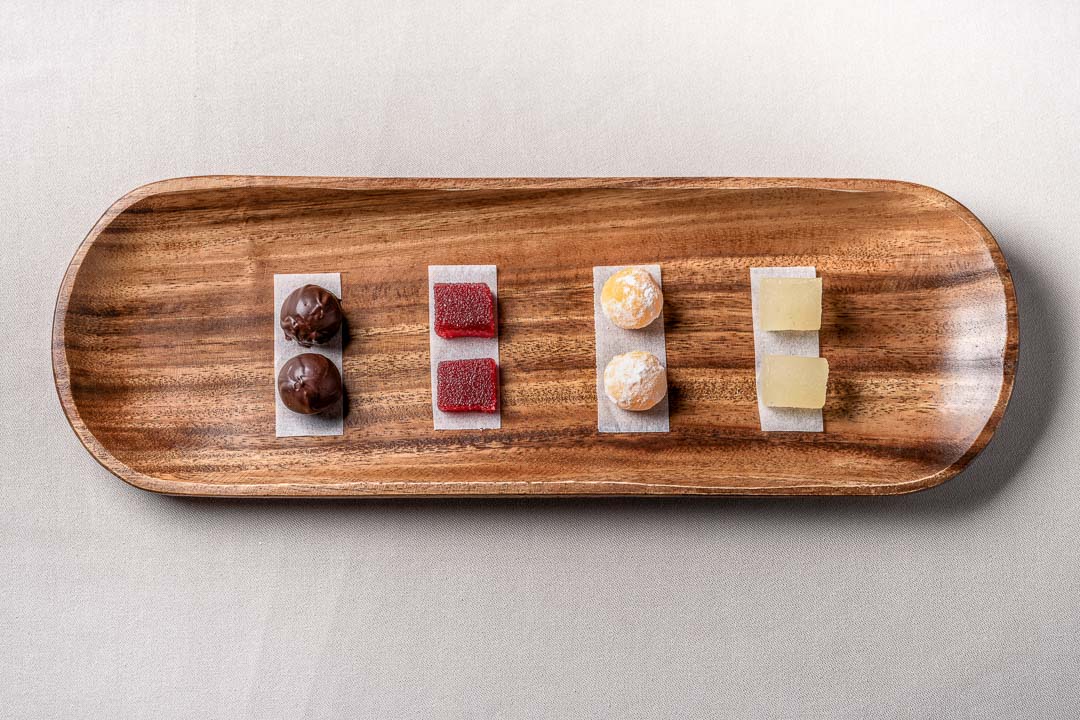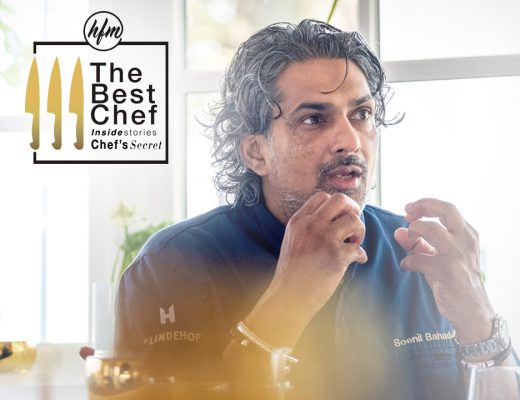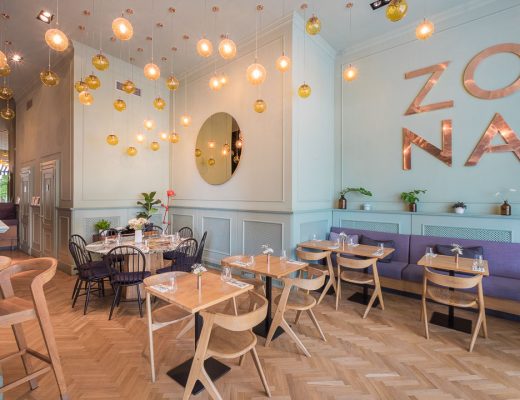Rarely has a restaurant location felt so fairytale-esque as the setting that surrounds El Lago restaurant in Marbella. Established in 1999, the Greenlife Golf Clubhouse in the heart of Elviria Hills is an idyllic place. From the start of their adventure, they have sought their own path, one based on an authentic, intimate and seasonal culinary discourse, where the main goal is to build a close rapport with a great team comprising artisan producers from the surrounding area. This commitment to the regional cuisine of Malaga and wider Andalusia, combining local top-quality produce and creativity, characterises the place. As the cherry on the cake, the restaurant was the first haute cuisine restaurant in Andalusia to be awarded the Km0 certificate by the international Slow Food organisation, which honours restaurants who only use ingredients cultivated within a radius of 100 km. El Lago also obtained a Michelin star in 2005.
A sustainable philosophy
Spanish gastronomy no longer needs an introduction, thanks to the Adrià brothers, Roca, David Muñoz and many others. Its strength lies within the creativity of the Spanish chefs, the use of seasonal produce and all the craft-producers supplying outstanding products from the seas and mountains, who deliver the best of their work on a daily basis. Proud of what Spain has to offer, the team at El Lago doesn’t want to abandon traditions. El Lago’s DNA lies within the authenticity and flavour of the terroir, and its natural ingredients. Their philosophy is based on proximity and involves a close, direct and sincere relationship with a large family of suppliers, many of whom have been collaborating with them for more than 15 years.
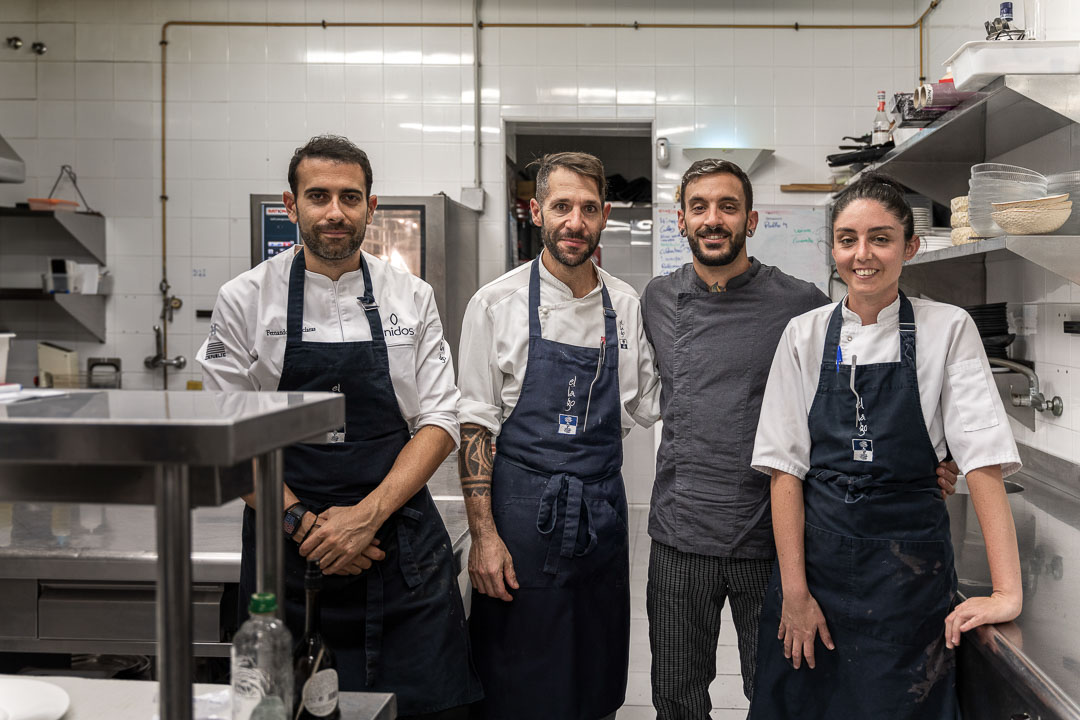
Breath-taking terrace views
With only 9 holes, the Greenlife Golf Clubhouse is an intimate and charming place with a well-balanced combination of luxury elements, that also manages to feel homely. That’s exactly the atmosphere the team wants to present to the guests at the restaurant as well. Inside, the classic, calm and understated interior has been consciously chosen. A palette of white and earthly hues ensures that one’s attention isn’t distracted and that the view outside remains the restaurant’s main decor.
Meet chef Fernando Villasclaras
Curious to learn more about the driving force behind this wonderful place, we take some time to get to know chef Fernando Villasclaras better. Over an informal chat, he talks about the importance of their local suppliers, his roots as a chef and why he still falls in love with Andalusian cuisine every single day.
Hungry for More: What’s your background as a chef? How did you end up at this location?
Fernando Villasclaras: As a young chef, I worked at a lot of places. When I was working in Mugaritz, I got a phone call asking if I wanted to come back to Andalusia. As I grew up in Nerja, this immediately felt like the right step to take because for me it was like coming home. However, finding a job as a creative chef at a restaurant isn’t easy in Marbella – unless you want to work in a hotel. Determined to follow my heart, I knew that hotel cuisine wasn’t my cup of tea. Luckily, I ended up in a small restaurant in Estepona. There, I had the chance to develop my own style and to grow as a chef. A lot of young chefs copy dishes and cooking ideas from others, but I think that the beauty (and challenge) lies within carving out your own path. Here at El Lago restaurant, I have the opportunity to follow my own vision every single day: introducing people to the typical cuisine of Malaga.
Hungry for More: Where does your passion for gastronomy come from?
Fernando Villasclaras: This might be a surprising answer, but as a child, I never felt a true calling to become a chef. And nobody in my family worked in the hospitality business. When restaurants like El Bulli opened their doors, the whole industry changed and I also felt the ‘chef-fire’ inside me. Being a chef is a great profession for those with a variety of abilities: you can combine and use all your interests and talents in the kitchen. That’s why the chef’s whites suit me so well.
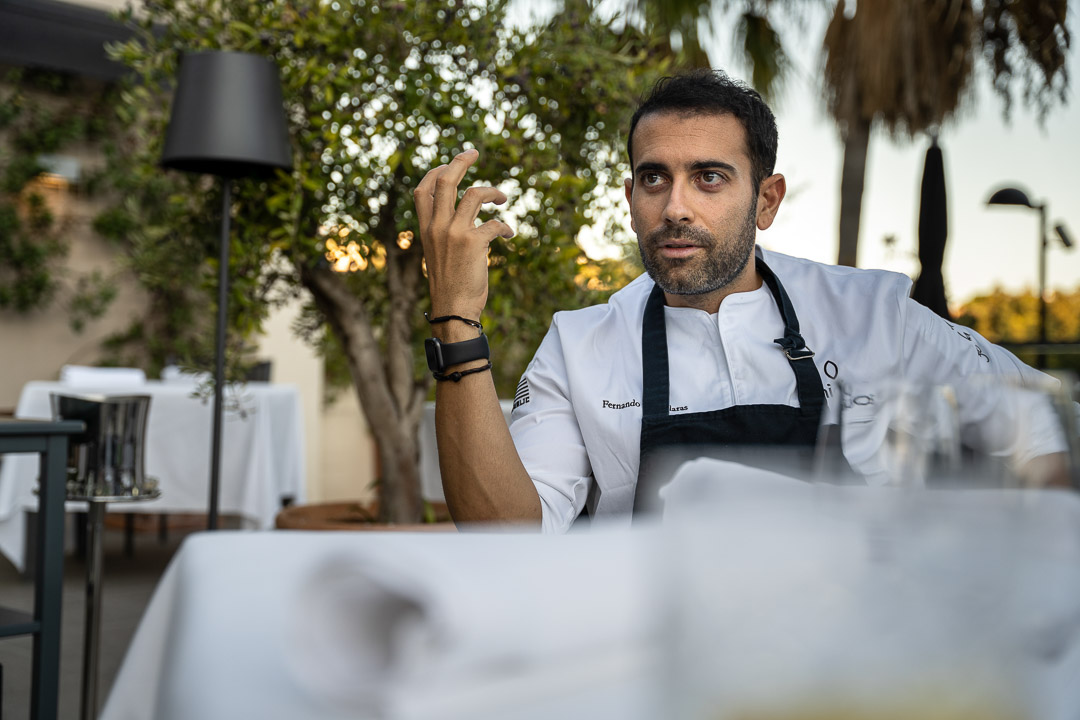
Hungry for More: Where do you find the inspiration to come up with new dishes? Are there certain ingredients, cuisines or chefs that inspire you?
Fernando Villasclaras: The produce forms the base of every single dish, that’s always my starting point. Then, I start thinking about techniques. How will I prepare this produce? Finally, I make sure that I always use seasonal produce. Besides the produce itself, Malaga’s culture also inspires me to come up with new dishes. When I first started working here, I dug into the history and recipes of Malaga. Based on that knowledge, I worked on new twists of some classics by giving them a ‘Fernando-touch’.
Hungry for More: What are your favourite ingredients to work with and why?
Fernando Villasclaras: Natural ingredients, fresh or processed at origin, are the main element of my daily work. Thanks to the sunny climate, we have top-quality vegetables here. That’s because the sun makes sure the vegetables produce more sugar and therefore more flavour. I love to include these delicious vegetables in my dishes, to such an extent that many dishes contain about 70% of vegetables. Besides vegetables, we’re lucky to have plenty of high-quality fish thanks to the Mediterranean Sea. That’s also the strength of El Lago restaurant. Long before it became well-known, we were already applying our 0 km philosophy.
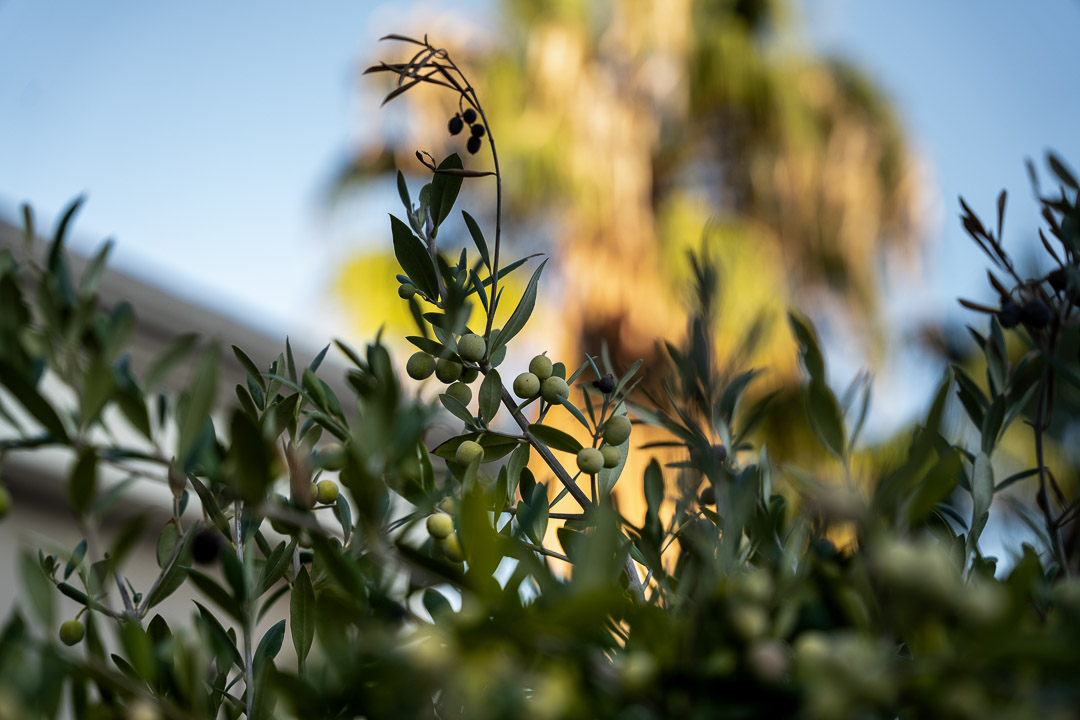
Hungry for More: How do you look for new local producers and suppliers?
Fernando Villasclaras: Good suppliers are worth their weight in gold, and luckily, we have a great network of artisans. Some of them have been part of the El Lago family for over 20 years. As we collaborate closely, we often have the luxury of choosing some of their best products. We also create dishes together. Take goat’s cheese for example, which used to be quite an unpopular product. Now, it’s frequently used. Our producers grow with us and vice versa, together we improve and optimise the products and recipes. Another example: the grapes in our latest dessert, those don’t seem high-quality grapes – that’s why traditionally they were only used for making sweet wine. However, we buy those types of grapes to make ice cream. In that way, we give the grapes a whole new purpose.
Hungry for More: In your opinion, what’s the typical Andalusian gastronomy? Why is it so special or unique?
Fernando Villasclaras: Andalusia has a strong food culture, thanks to all the Andalusian chefs who have travelled all over the world. When they come back, they combine their global experience of gastronomy at the highest level with the local Andalusian cuisine – which tend to be a match made in heaven. It is also thanks to great chefs such as Daniel García or Paco Morales – to name just a few – that we can do what we are doing today. Those prominent names in the world of gastronomy have opened doors for younger chefs like me. Now it is acceptable to be creative. Back then, it was for more difficult.
Hungry for More: What do you want guests to remember after visiting El Lago restaurant?
Fernando Villasclaras: In Malaga we have the best products in the world, combined with a delicious, welcoming food culture. In our region there are places where only the locals go and dishes they truly love. Dried octopus for example might sound a bit strange, but here it’s a popular ingredient. It’s then up to us – creative chefs – to create a dish that our guests will love. In addition, one of our guiding principles is that anyone visiting us should to some extent get to know our producers, their production systems and their artisanal techniques.
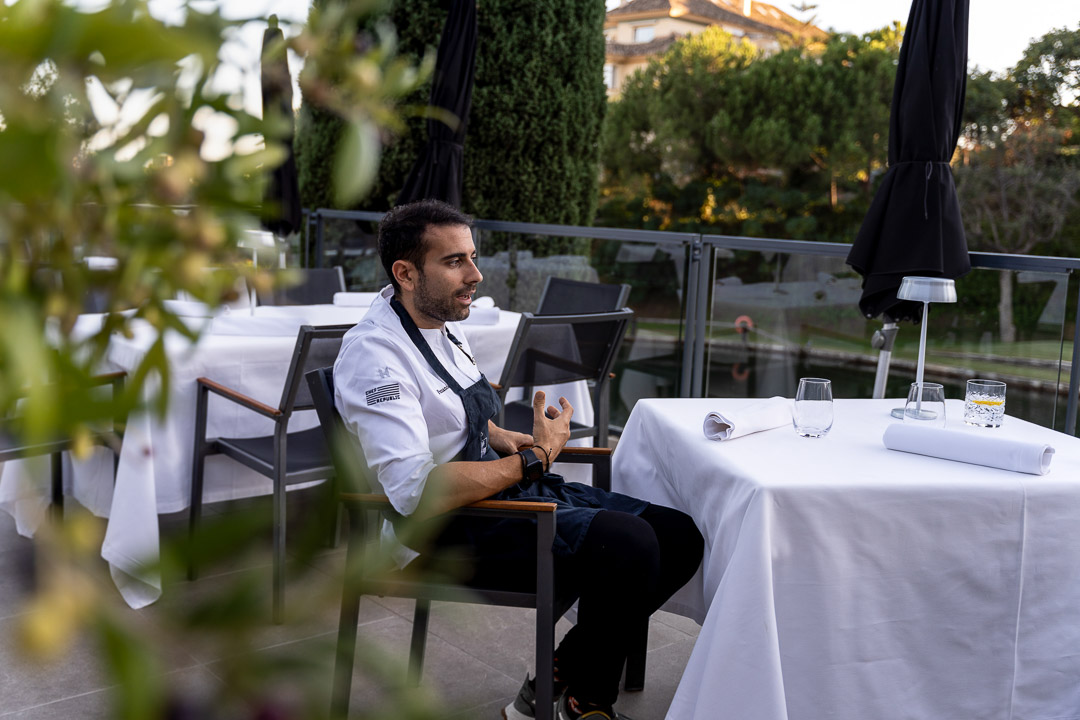
The full Marbella experience
As this interesting chat with the chef is making our mouths water already, we can’t wait to discover the secrets of Andalusian cuisine. In the afternoon, the chef and his team serve up an affordable lunch with their concept ‘Midi by El Lago’. However, in the evening they go all out and offer a more high-end experience and menu. In addition to the à la carte dishes, the chef and his team also create the ‘Sazón’ menu, which stands for the point of maturity or perfection reached by a thing in its development or evolution, combined with a suitable state of the soil for planting and cultivation.
Their love for Andalusia is not only reflected in the menu, but also in the wine list. You can choose between a wine pairing of Spanish wines from all over the country and a local pairing of wines from the region itself, e.g., Malaga or Ronda. As the chef has already convinced us of the richness of Andalusian cuisine, we’re happy to try the local wine pairing as well.
The menu kicks off with a sequence of seasonal appetisers, a selection of 3 types of bread and 2 different olive oils:
- Aloreña olive ‘butter’ with steamed ‘mollete’ rolls by AOVE from Antequera. With the steamed bread, the chef seeks to remind us of our childhood. The butter is not actually real butter, although it does look like it at first glance. The soft, creamy spread is in fact made from olives;
- Tangerine, pickled fennel and carrots with cumin dressing;
- A salty meringue macaron with lactic cheese from Coin and a cream of grilled peppers;
- Red prawns, mango and jalapeño with ‘Riofrío’ caviar from Granada.
The appetisers are followed by grilled figs, red tuna tartare from Almadraba and black garlic.
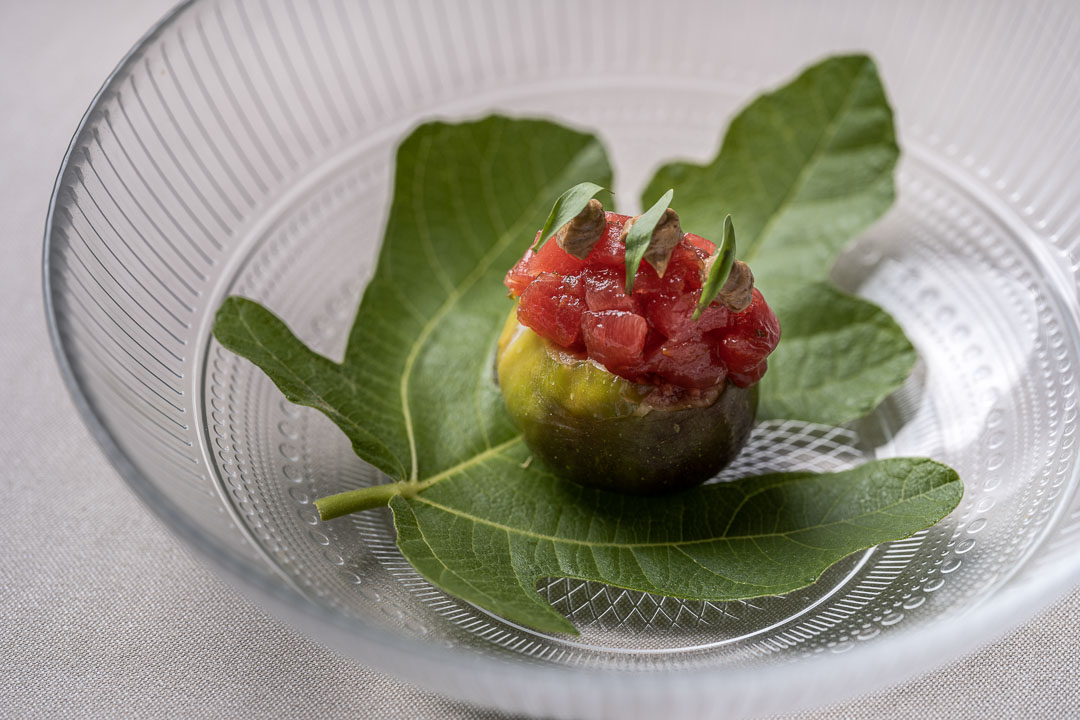
We try a dish of beetroot and strawberry ‘porra’, tartare, goat’s cheese and a green mustard sorbet.
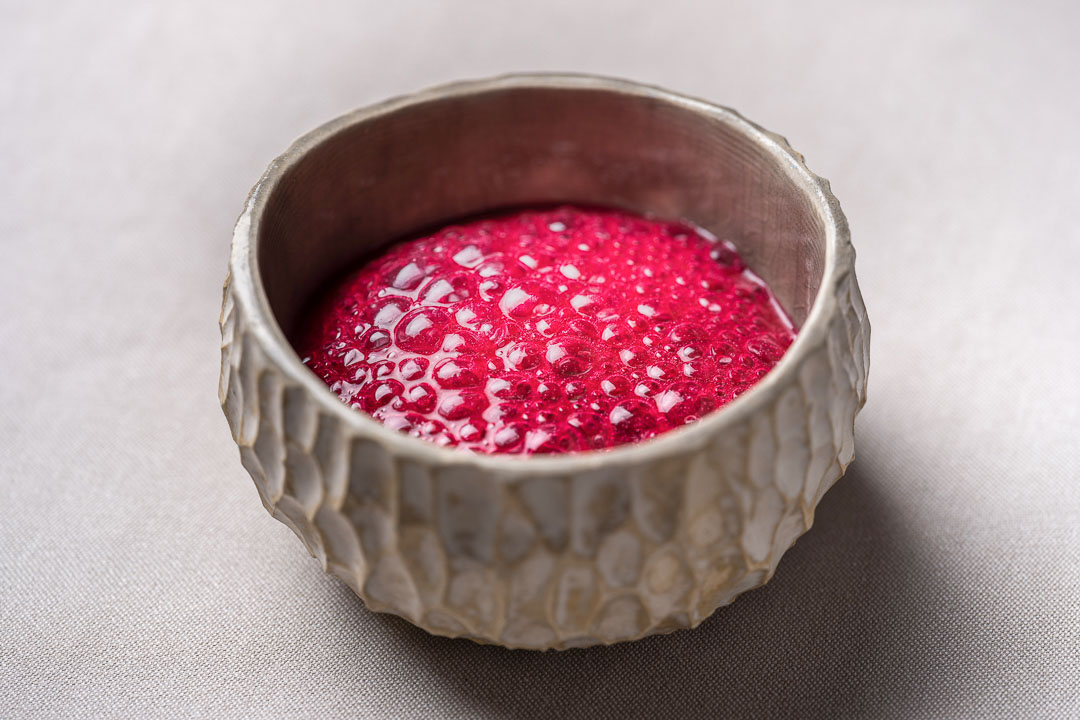
We’re lucky to get an extra dish served by the chef: seasonal vegetables with citrus, or as the chef likes to call it ‘ceviche without the fish’.
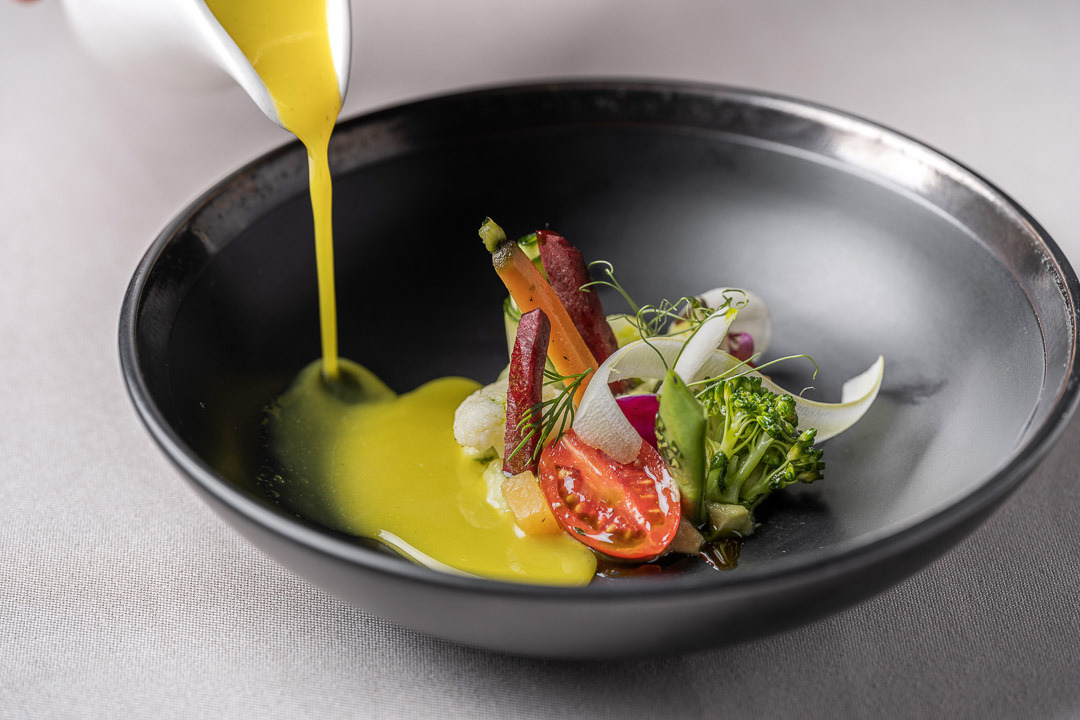
Next up: cuttlefish in a yellow sauce, a modern take on a traditional dish.
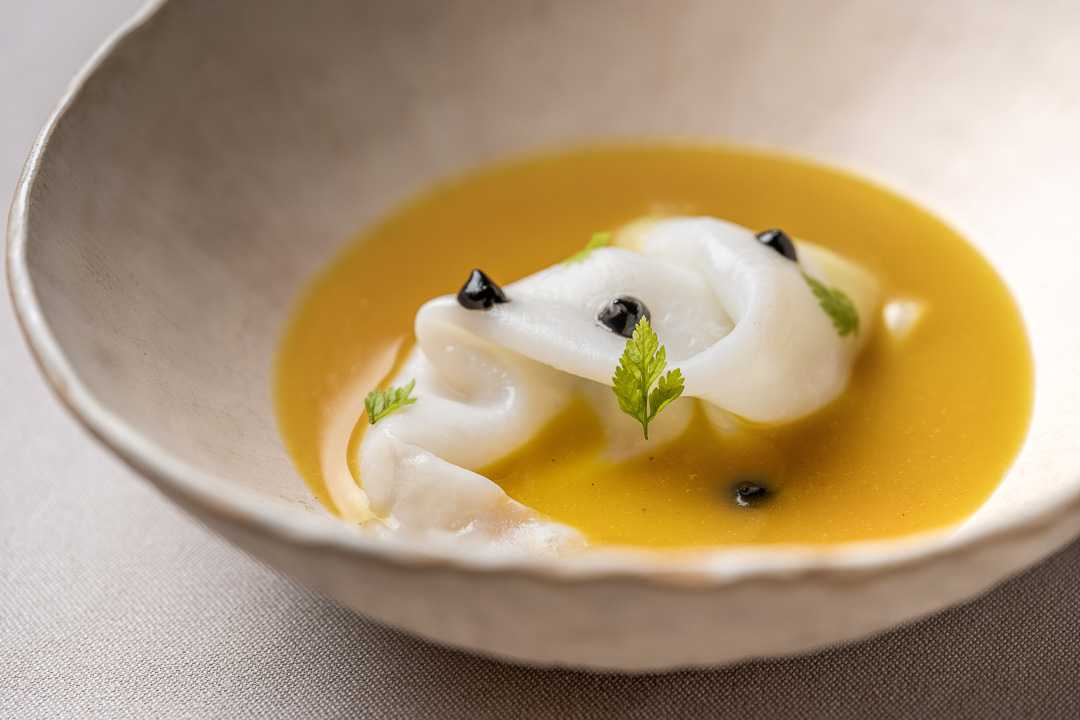
Then we savour a millefeuille of eggplant and a tartelette.
The following course dishes up grilled veal sweetbreads in bigarade sauce, with beef juice and lemon, combined with razor shellfish tartare, fermented black almonds and harissa.
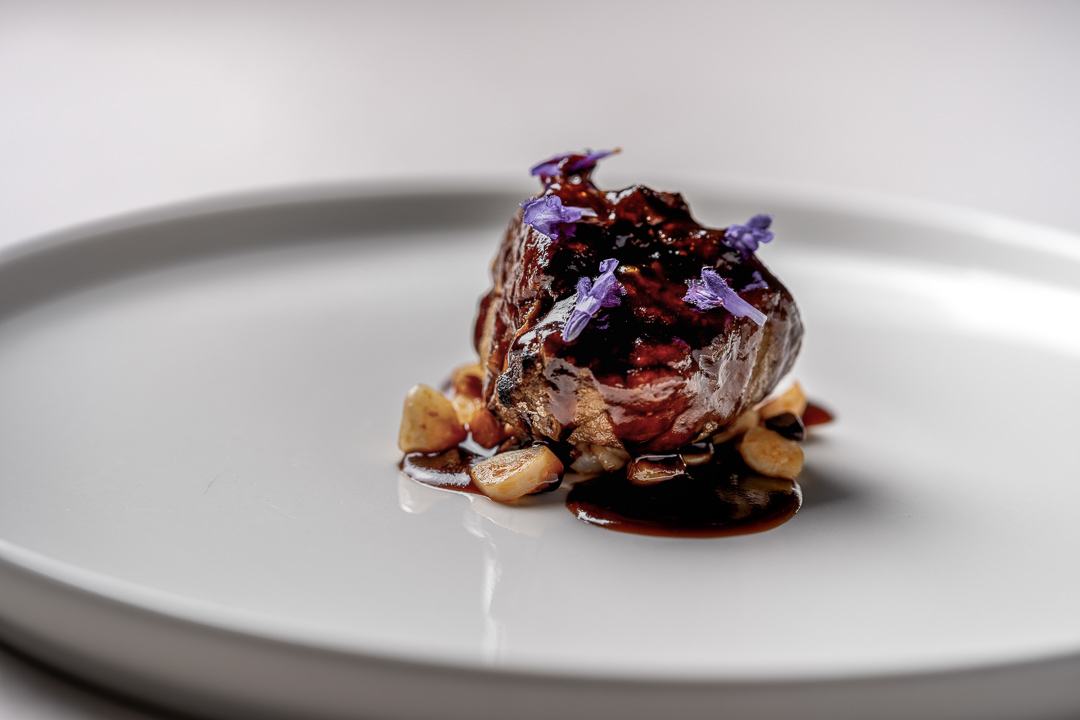
One of the chef’s favourite products to work with is red mullet. He combines the fish with hot Andalusian majao, a kind of toasted bread, and livers.
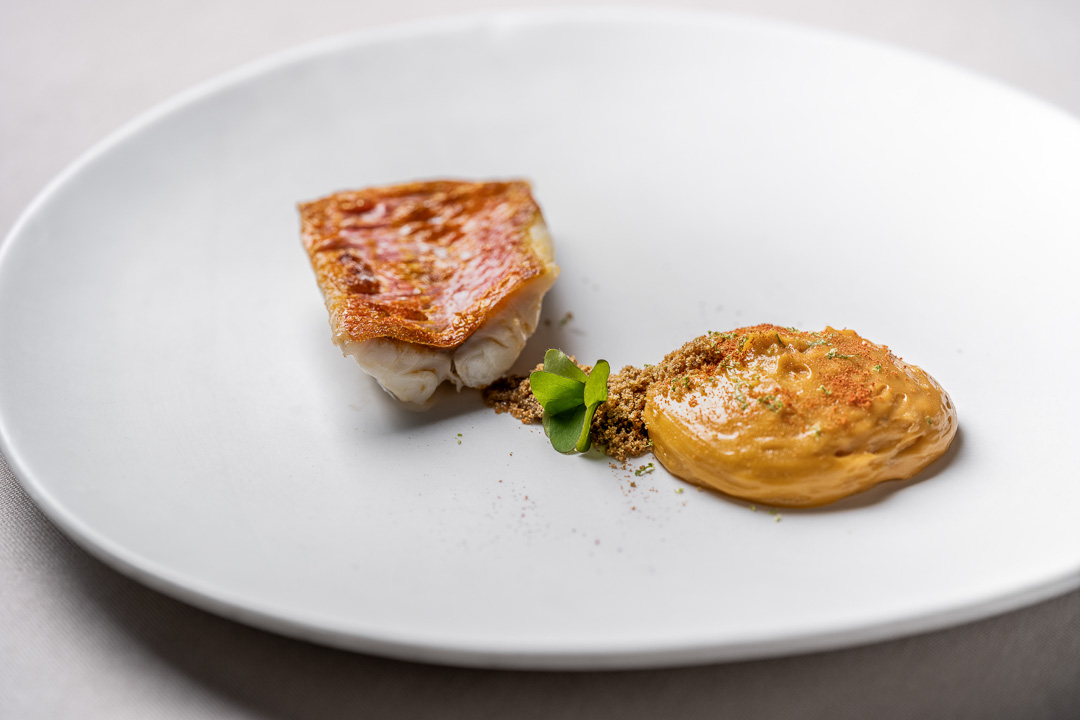
We continue with suckling goat neck with creamy Payoyo cheese, oysters and lime.
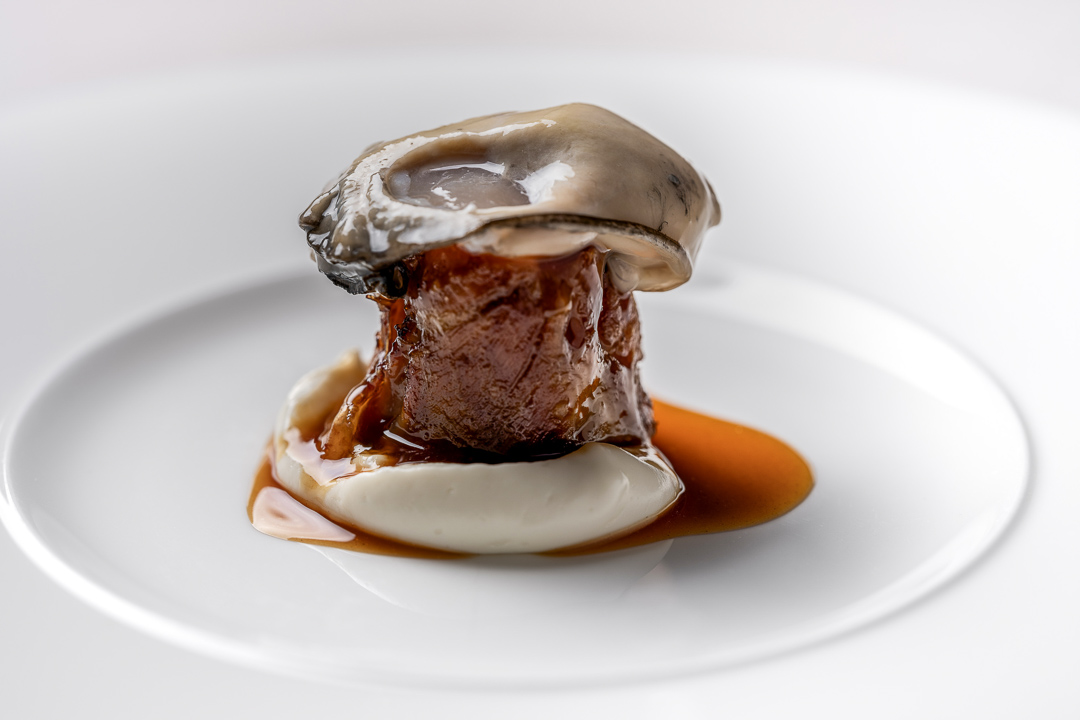
The first dessert is called ‘La Axarquía’— sweet potatoes with caña honey, lychee and cinnamon.
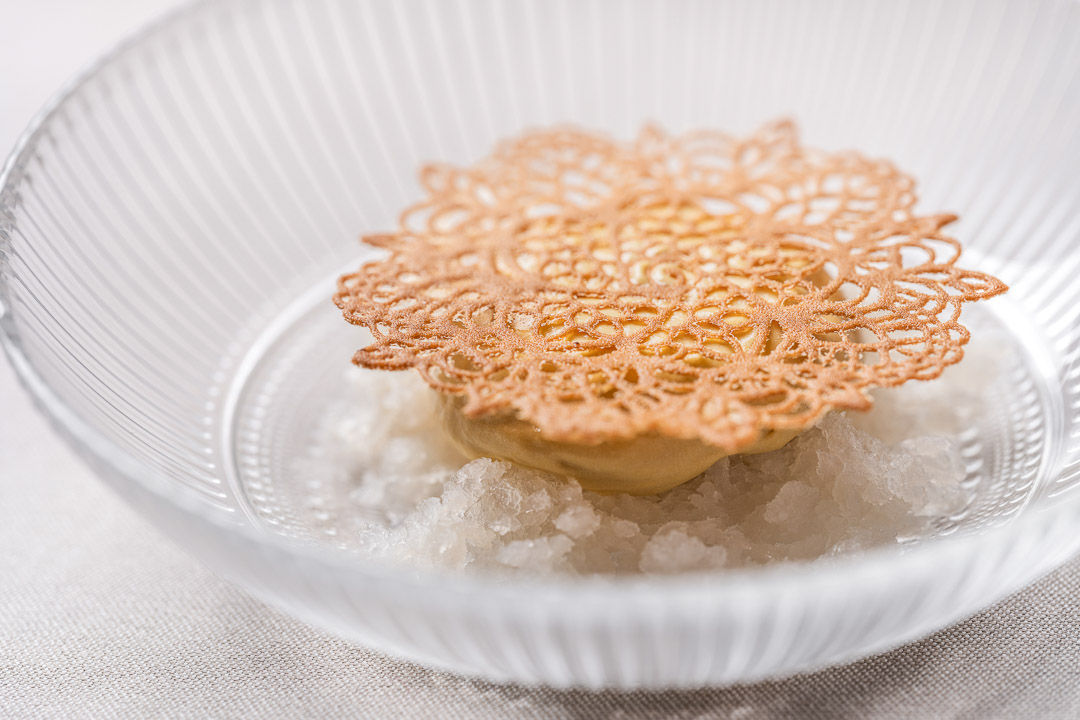
The last dessert is based on an old recipe and made with the grapes the chef told us about. Uvate: pumpkin infused in milk meringue with rose water and muscatel grape sorbet.
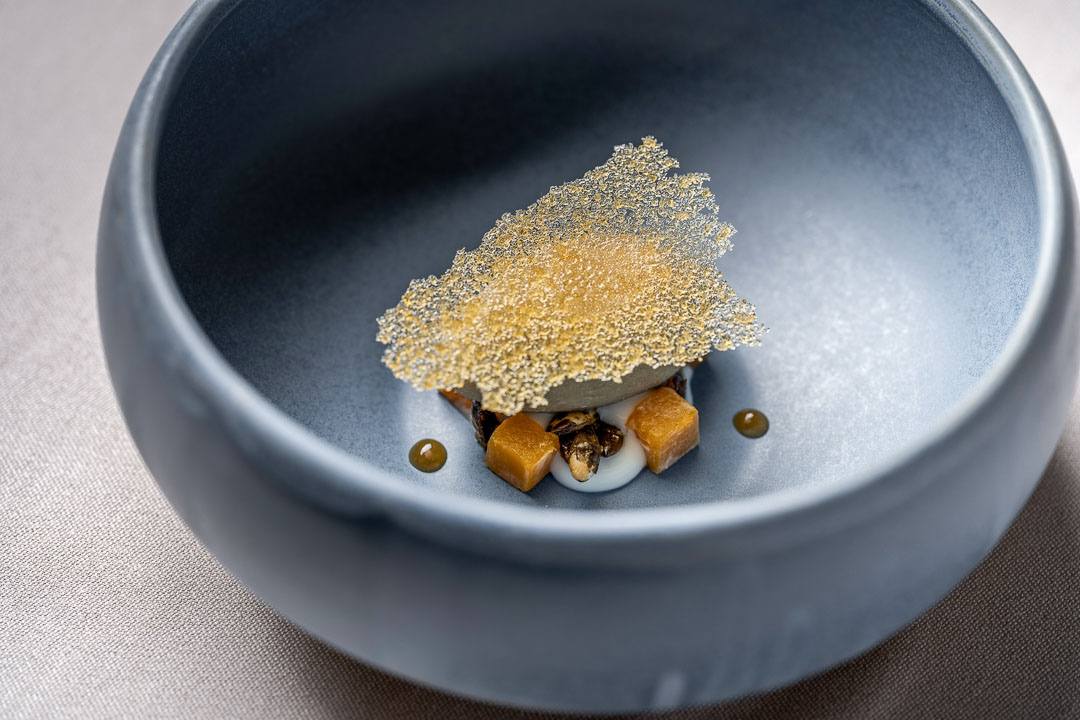
We end our culinary experience at El Lago with coffee, a selection of cakes and a final mesmerising view of the golf course.
In short
Thanks to the atmospheric table lamps, panoramic views over the golf course, a beautiful fountain in the centre and a warm summer breeze all season long (for free!), here, guests can enjoy the Andalusian cuisine of chef Fernando Villasclaras and his team at its finest.
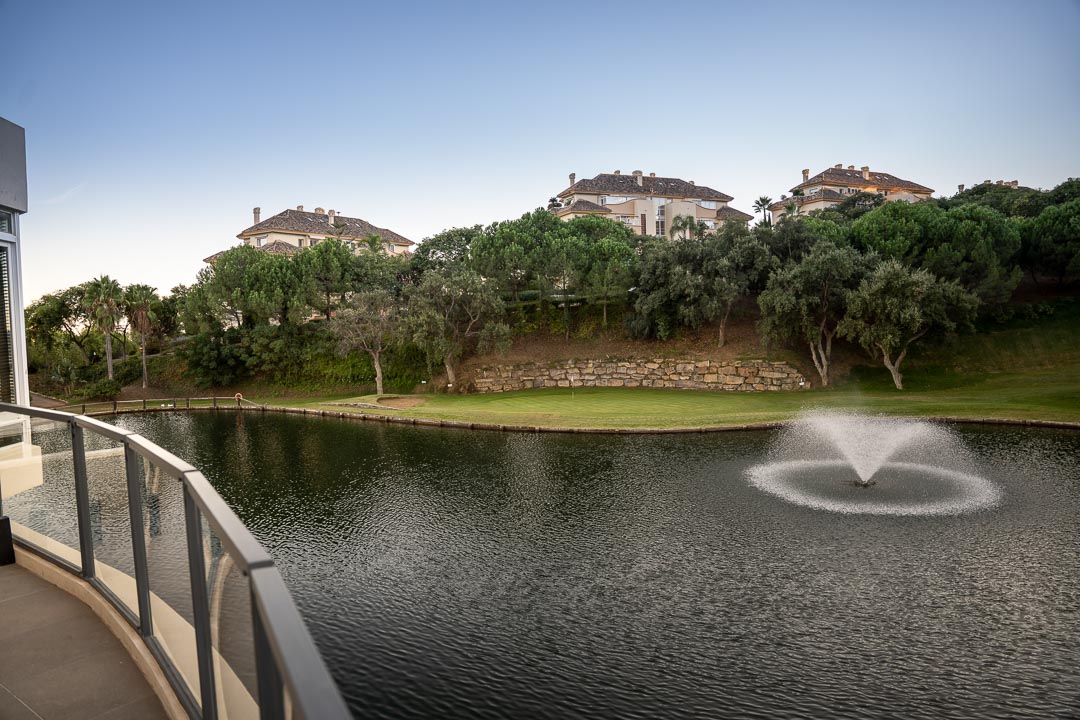
Practical information
El Lago restaurant, Urb. Elviria Hills, Avda. Marco Polo s/n – 29604 Marbella, Spain | +34 95 28 32 37| restaurante@restauranteellago.com | www.restauranteellago.com | www.facebook.com/RestauranteElLagoMarbella | www.instagram.com/ellagorestaurante


